Retrofitting UTS Building 15: A Sustainable Urban Development Report
VerifiedAdded on 2023/02/01
|16
|3553
|71
Report
AI Summary
This report presents a comprehensive sustainable retrofit plan for UTS Building 15, focusing on various aspects of urban development. The analysis begins with an executive summary and introduction, followed by detailed information about the building's water usage, energy consumption, daylight availability, and existing building management system. The report assesses the roofing, green space management, and floor characteristics, identifying areas for improvement. A retrofitting plan is proposed, outlining short-term, mid-term, and long-term solutions. These include repainting the facade, implementing rainwater harvesting systems, and upgrading floors. The plan also addresses water management, design considerations, and energy utilization. Recommendations are categorized by timeframe, offering practical solutions for smart investment and low-cost, high-impact improvements. The report concludes with a summary of the findings and a list of references. The report offers a detailed assessment and actionable strategies for enhancing the building's sustainability, making it a valuable resource for urban development and environmental engineering.
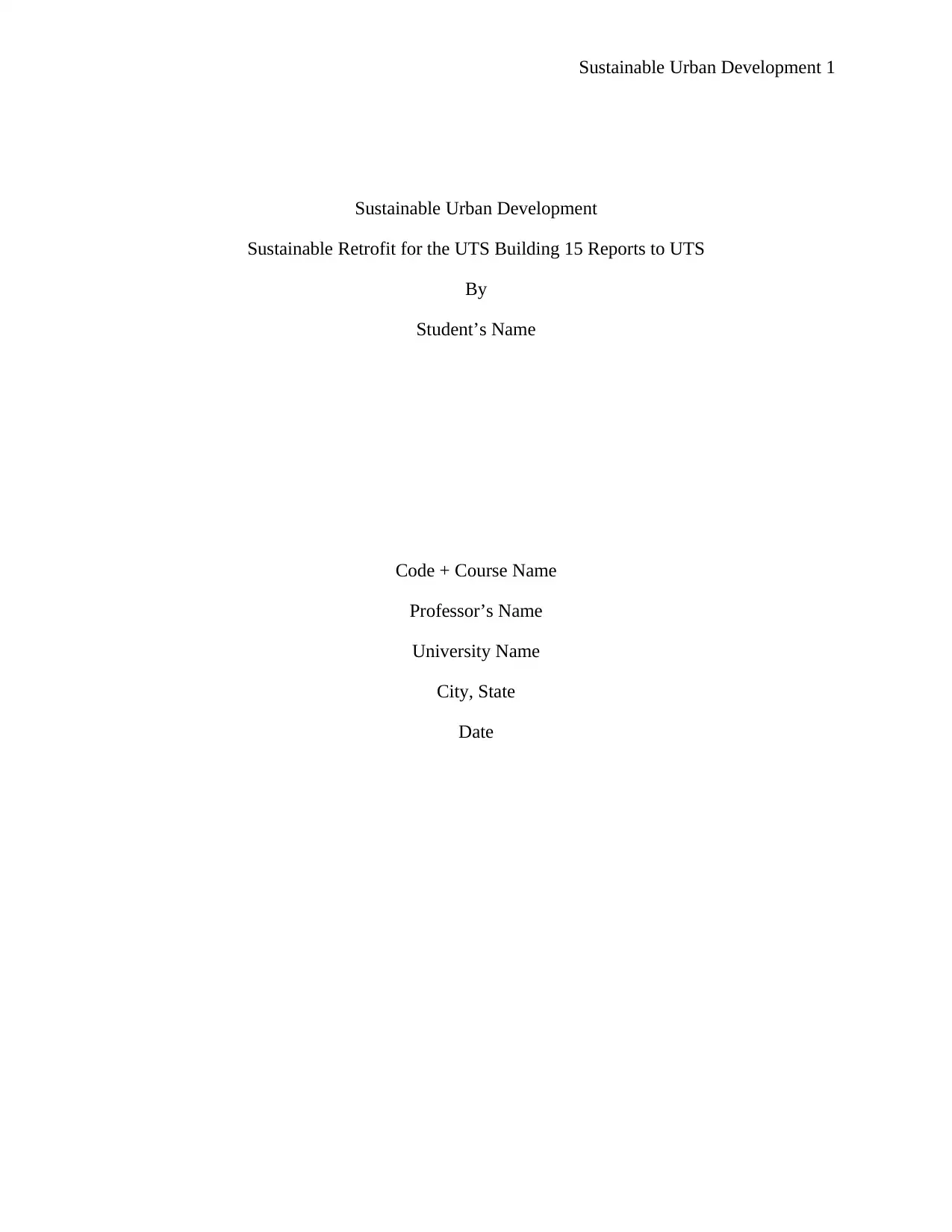
Sustainable Urban Development 1
Sustainable Urban Development
Sustainable Retrofit for the UTS Building 15 Reports to UTS
By
Student’s Name
Code + Course Name
Professor’s Name
University Name
City, State
Date
Sustainable Urban Development
Sustainable Retrofit for the UTS Building 15 Reports to UTS
By
Student’s Name
Code + Course Name
Professor’s Name
University Name
City, State
Date
Paraphrase This Document
Need a fresh take? Get an instant paraphrase of this document with our AI Paraphraser
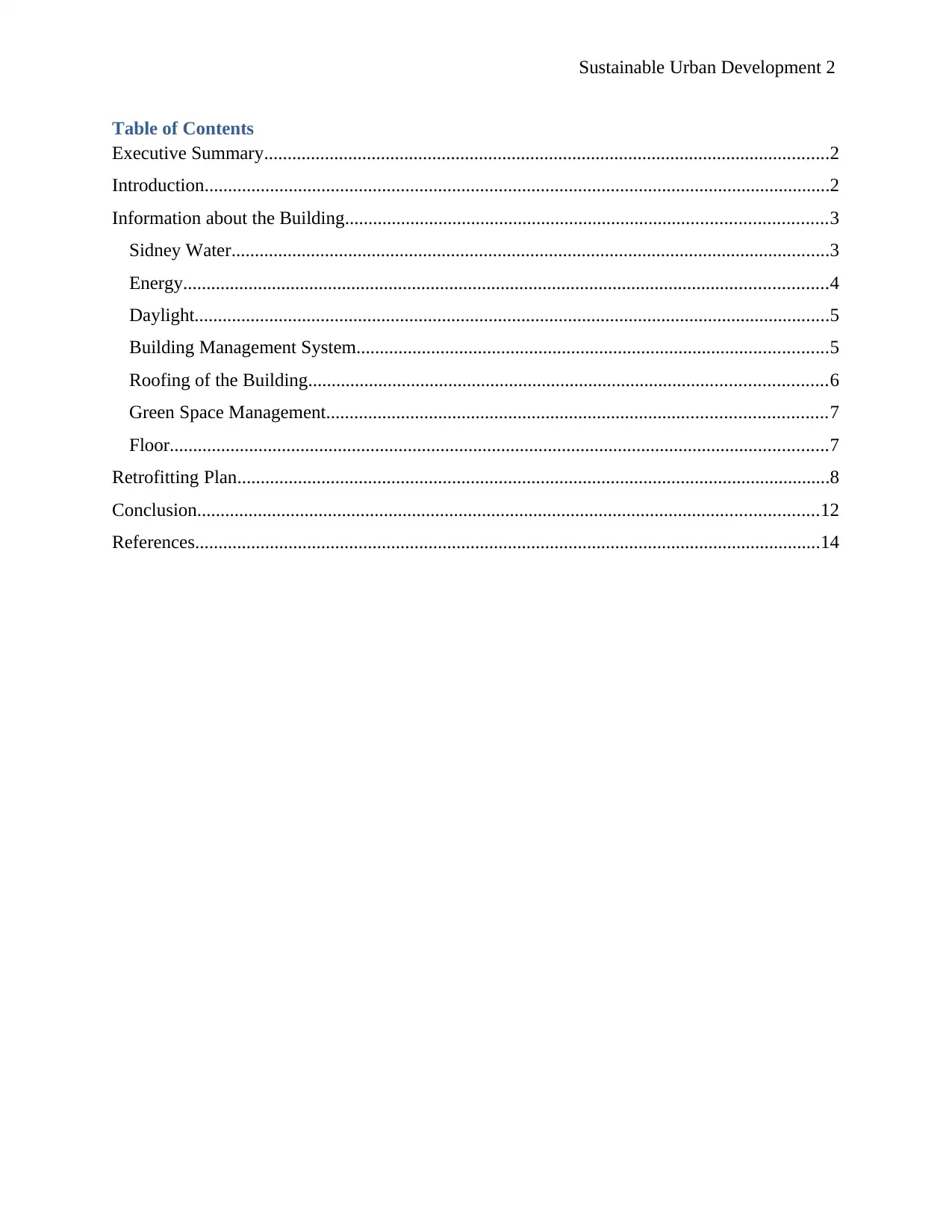
Sustainable Urban Development 2
Table of Contents
Executive Summary.........................................................................................................................2
Introduction......................................................................................................................................2
Information about the Building.......................................................................................................3
Sidney Water................................................................................................................................3
Energy..........................................................................................................................................4
Daylight........................................................................................................................................5
Building Management System.....................................................................................................5
Roofing of the Building...............................................................................................................6
Green Space Management...........................................................................................................7
Floor.............................................................................................................................................7
Retrofitting Plan...............................................................................................................................8
Conclusion.....................................................................................................................................12
References......................................................................................................................................14
Table of Contents
Executive Summary.........................................................................................................................2
Introduction......................................................................................................................................2
Information about the Building.......................................................................................................3
Sidney Water................................................................................................................................3
Energy..........................................................................................................................................4
Daylight........................................................................................................................................5
Building Management System.....................................................................................................5
Roofing of the Building...............................................................................................................6
Green Space Management...........................................................................................................7
Floor.............................................................................................................................................7
Retrofitting Plan...............................................................................................................................8
Conclusion.....................................................................................................................................12
References......................................................................................................................................14
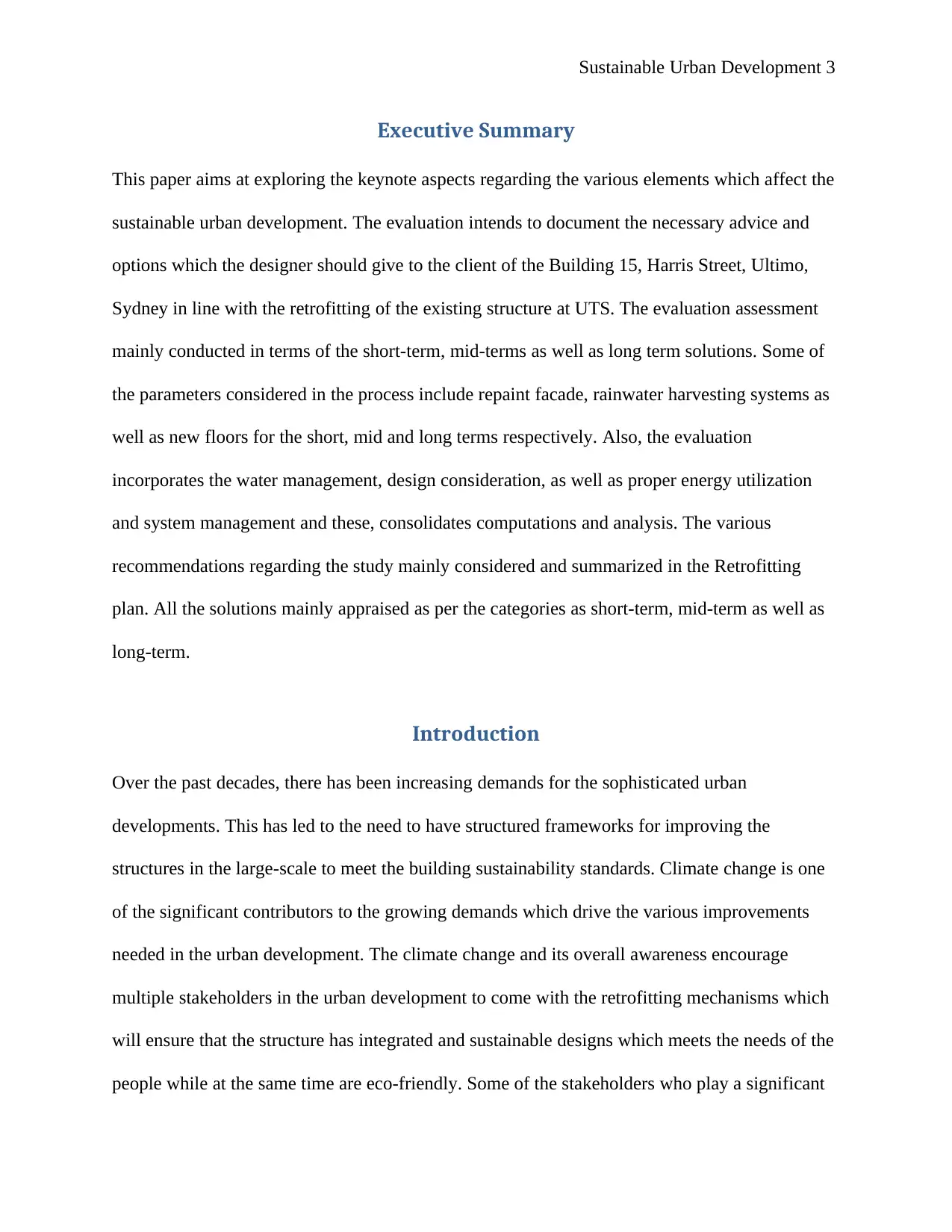
Sustainable Urban Development 3
Executive Summary
This paper aims at exploring the keynote aspects regarding the various elements which affect the
sustainable urban development. The evaluation intends to document the necessary advice and
options which the designer should give to the client of the Building 15, Harris Street, Ultimo,
Sydney in line with the retrofitting of the existing structure at UTS. The evaluation assessment
mainly conducted in terms of the short-term, mid-terms as well as long term solutions. Some of
the parameters considered in the process include repaint facade, rainwater harvesting systems as
well as new floors for the short, mid and long terms respectively. Also, the evaluation
incorporates the water management, design consideration, as well as proper energy utilization
and system management and these, consolidates computations and analysis. The various
recommendations regarding the study mainly considered and summarized in the Retrofitting
plan. All the solutions mainly appraised as per the categories as short-term, mid-term as well as
long-term.
Introduction
Over the past decades, there has been increasing demands for the sophisticated urban
developments. This has led to the need to have structured frameworks for improving the
structures in the large-scale to meet the building sustainability standards. Climate change is one
of the significant contributors to the growing demands which drive the various improvements
needed in the urban development. The climate change and its overall awareness encourage
multiple stakeholders in the urban development to come with the retrofitting mechanisms which
will ensure that the structure has integrated and sustainable designs which meets the needs of the
people while at the same time are eco-friendly. Some of the stakeholders who play a significant
Executive Summary
This paper aims at exploring the keynote aspects regarding the various elements which affect the
sustainable urban development. The evaluation intends to document the necessary advice and
options which the designer should give to the client of the Building 15, Harris Street, Ultimo,
Sydney in line with the retrofitting of the existing structure at UTS. The evaluation assessment
mainly conducted in terms of the short-term, mid-terms as well as long term solutions. Some of
the parameters considered in the process include repaint facade, rainwater harvesting systems as
well as new floors for the short, mid and long terms respectively. Also, the evaluation
incorporates the water management, design consideration, as well as proper energy utilization
and system management and these, consolidates computations and analysis. The various
recommendations regarding the study mainly considered and summarized in the Retrofitting
plan. All the solutions mainly appraised as per the categories as short-term, mid-term as well as
long-term.
Introduction
Over the past decades, there has been increasing demands for the sophisticated urban
developments. This has led to the need to have structured frameworks for improving the
structures in the large-scale to meet the building sustainability standards. Climate change is one
of the significant contributors to the growing demands which drive the various improvements
needed in the urban development. The climate change and its overall awareness encourage
multiple stakeholders in the urban development to come with the retrofitting mechanisms which
will ensure that the structure has integrated and sustainable designs which meets the needs of the
people while at the same time are eco-friendly. Some of the stakeholders who play a significant
⊘ This is a preview!⊘
Do you want full access?
Subscribe today to unlock all pages.

Trusted by 1+ million students worldwide
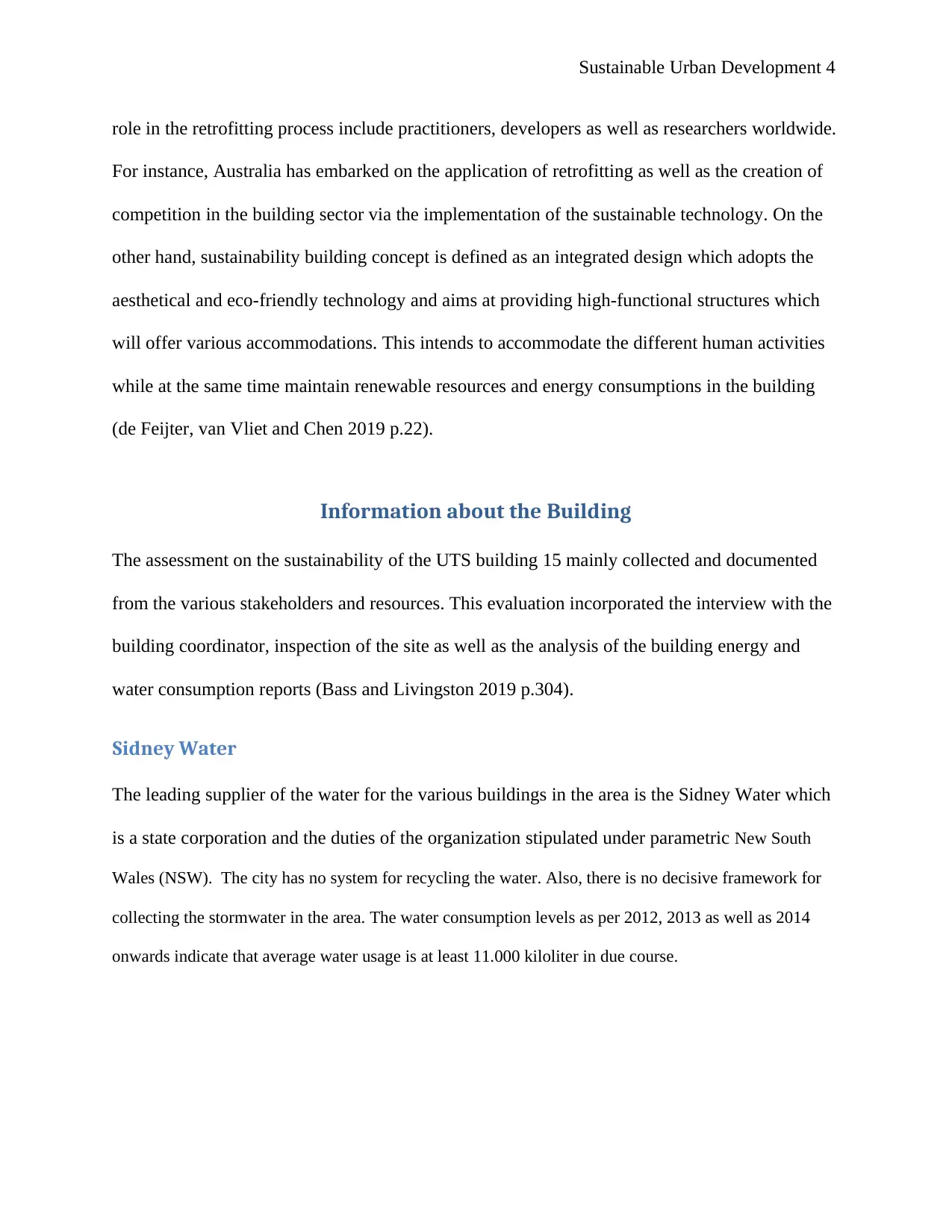
Sustainable Urban Development 4
role in the retrofitting process include practitioners, developers as well as researchers worldwide.
For instance, Australia has embarked on the application of retrofitting as well as the creation of
competition in the building sector via the implementation of the sustainable technology. On the
other hand, sustainability building concept is defined as an integrated design which adopts the
aesthetical and eco-friendly technology and aims at providing high-functional structures which
will offer various accommodations. This intends to accommodate the different human activities
while at the same time maintain renewable resources and energy consumptions in the building
(de Feijter, van Vliet and Chen 2019 p.22).
Information about the Building
The assessment on the sustainability of the UTS building 15 mainly collected and documented
from the various stakeholders and resources. This evaluation incorporated the interview with the
building coordinator, inspection of the site as well as the analysis of the building energy and
water consumption reports (Bass and Livingston 2019 p.304).
Sidney Water
The leading supplier of the water for the various buildings in the area is the Sidney Water which
is a state corporation and the duties of the organization stipulated under parametric New South
Wales (NSW). The city has no system for recycling the water. Also, there is no decisive framework for
collecting the stormwater in the area. The water consumption levels as per 2012, 2013 as well as 2014
onwards indicate that average water usage is at least 11.000 kiloliter in due course.
role in the retrofitting process include practitioners, developers as well as researchers worldwide.
For instance, Australia has embarked on the application of retrofitting as well as the creation of
competition in the building sector via the implementation of the sustainable technology. On the
other hand, sustainability building concept is defined as an integrated design which adopts the
aesthetical and eco-friendly technology and aims at providing high-functional structures which
will offer various accommodations. This intends to accommodate the different human activities
while at the same time maintain renewable resources and energy consumptions in the building
(de Feijter, van Vliet and Chen 2019 p.22).
Information about the Building
The assessment on the sustainability of the UTS building 15 mainly collected and documented
from the various stakeholders and resources. This evaluation incorporated the interview with the
building coordinator, inspection of the site as well as the analysis of the building energy and
water consumption reports (Bass and Livingston 2019 p.304).
Sidney Water
The leading supplier of the water for the various buildings in the area is the Sidney Water which
is a state corporation and the duties of the organization stipulated under parametric New South
Wales (NSW). The city has no system for recycling the water. Also, there is no decisive framework for
collecting the stormwater in the area. The water consumption levels as per 2012, 2013 as well as 2014
onwards indicate that average water usage is at least 11.000 kiloliter in due course.
Paraphrase This Document
Need a fresh take? Get an instant paraphrase of this document with our AI Paraphraser
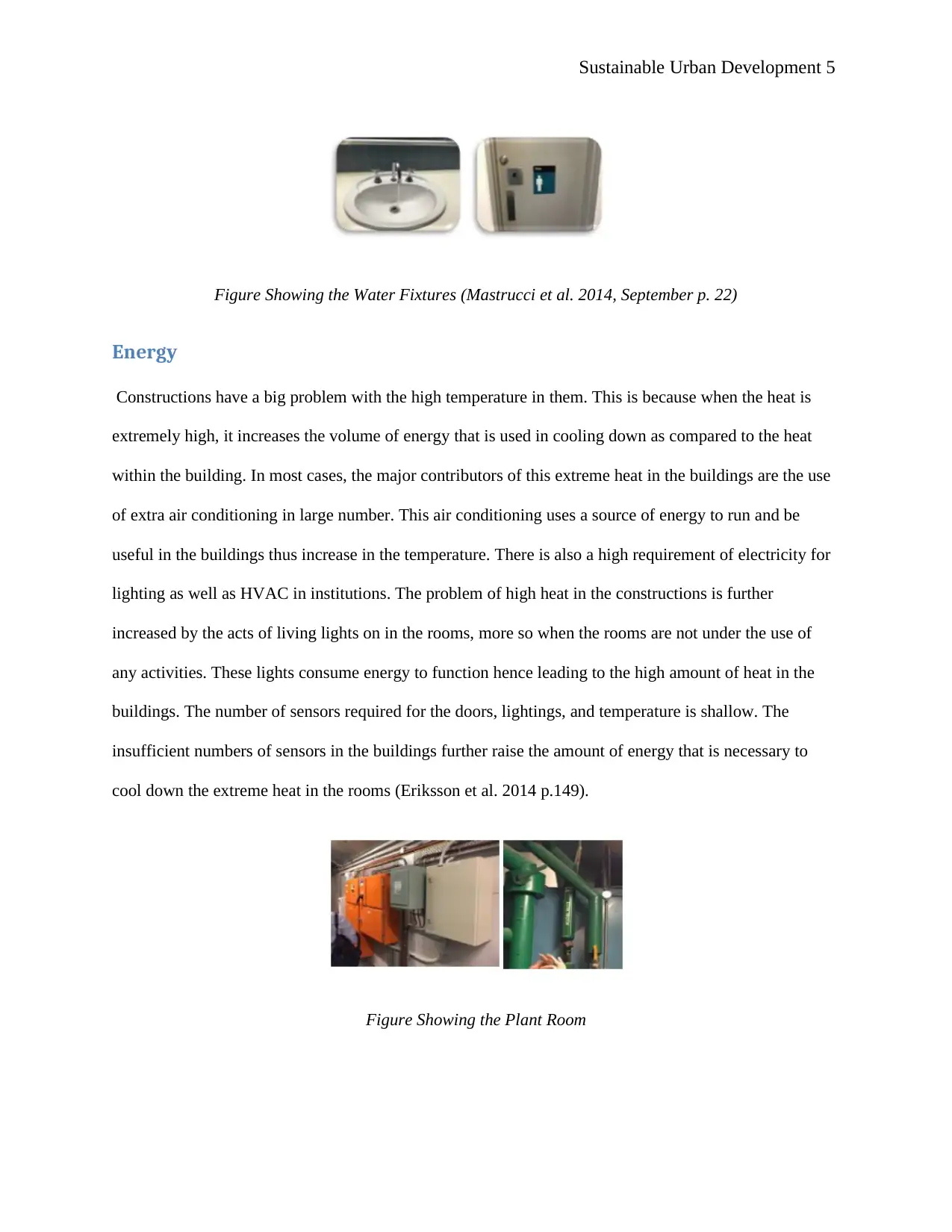
Sustainable Urban Development 5
Figure Showing the Water Fixtures (Mastrucci et al. 2014, September p. 22)
Energy
Constructions have a big problem with the high temperature in them. This is because when the heat is
extremely high, it increases the volume of energy that is used in cooling down as compared to the heat
within the building. In most cases, the major contributors of this extreme heat in the buildings are the use
of extra air conditioning in large number. This air conditioning uses a source of energy to run and be
useful in the buildings thus increase in the temperature. There is also a high requirement of electricity for
lighting as well as HVAC in institutions. The problem of high heat in the constructions is further
increased by the acts of living lights on in the rooms, more so when the rooms are not under the use of
any activities. These lights consume energy to function hence leading to the high amount of heat in the
buildings. The number of sensors required for the doors, lightings, and temperature is shallow. The
insufficient numbers of sensors in the buildings further raise the amount of energy that is necessary to
cool down the extreme heat in the rooms (Eriksson et al. 2014 p.149).
Figure Showing the Plant Room
Figure Showing the Water Fixtures (Mastrucci et al. 2014, September p. 22)
Energy
Constructions have a big problem with the high temperature in them. This is because when the heat is
extremely high, it increases the volume of energy that is used in cooling down as compared to the heat
within the building. In most cases, the major contributors of this extreme heat in the buildings are the use
of extra air conditioning in large number. This air conditioning uses a source of energy to run and be
useful in the buildings thus increase in the temperature. There is also a high requirement of electricity for
lighting as well as HVAC in institutions. The problem of high heat in the constructions is further
increased by the acts of living lights on in the rooms, more so when the rooms are not under the use of
any activities. These lights consume energy to function hence leading to the high amount of heat in the
buildings. The number of sensors required for the doors, lightings, and temperature is shallow. The
insufficient numbers of sensors in the buildings further raise the amount of energy that is necessary to
cool down the extreme heat in the rooms (Eriksson et al. 2014 p.149).
Figure Showing the Plant Room
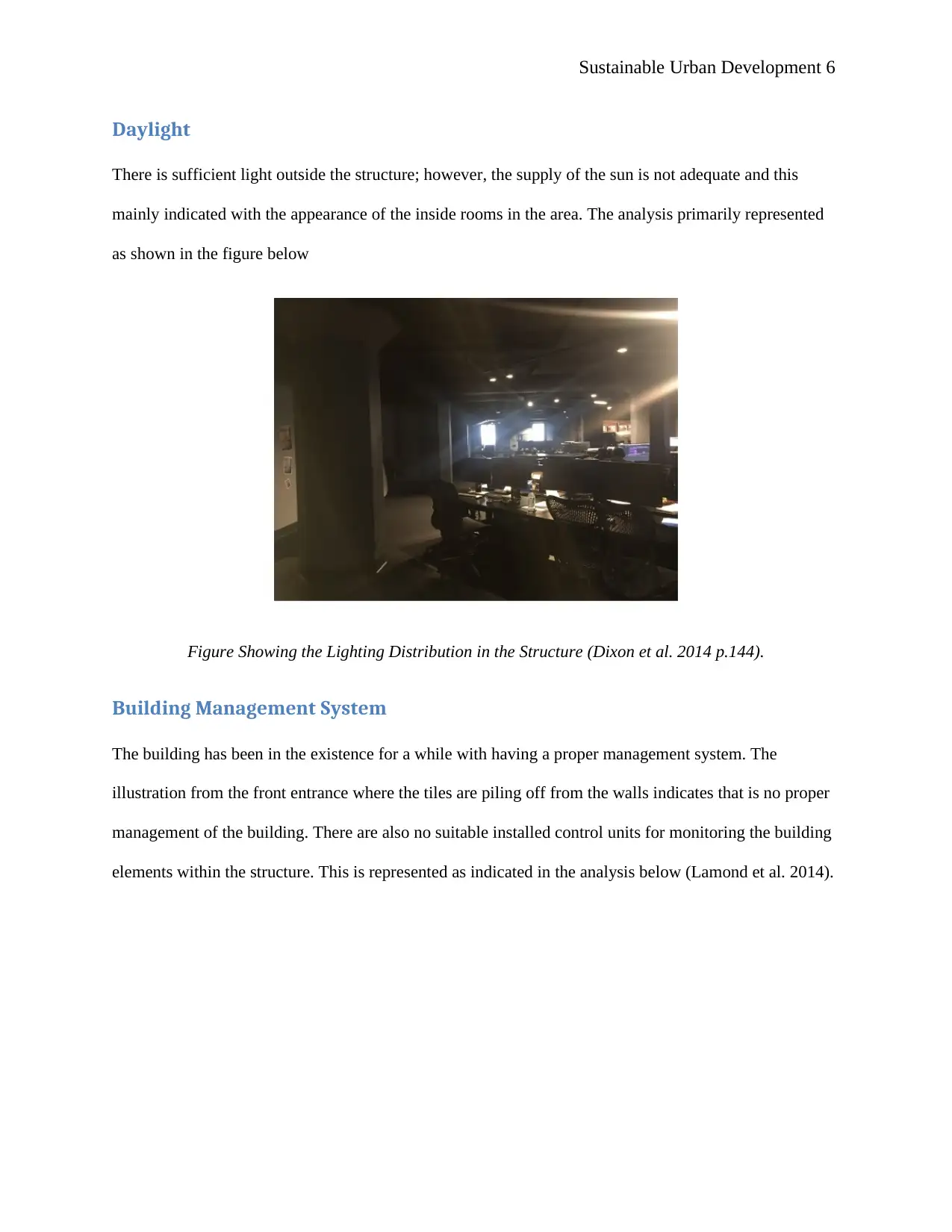
Sustainable Urban Development 6
Daylight
There is sufficient light outside the structure; however, the supply of the sun is not adequate and this
mainly indicated with the appearance of the inside rooms in the area. The analysis primarily represented
as shown in the figure below
Figure Showing the Lighting Distribution in the Structure (Dixon et al. 2014 p.144).
Building Management System
The building has been in the existence for a while with having a proper management system. The
illustration from the front entrance where the tiles are piling off from the walls indicates that is no proper
management of the building. There are also no suitable installed control units for monitoring the building
elements within the structure. This is represented as indicated in the analysis below (Lamond et al. 2014).
Daylight
There is sufficient light outside the structure; however, the supply of the sun is not adequate and this
mainly indicated with the appearance of the inside rooms in the area. The analysis primarily represented
as shown in the figure below
Figure Showing the Lighting Distribution in the Structure (Dixon et al. 2014 p.144).
Building Management System
The building has been in the existence for a while with having a proper management system. The
illustration from the front entrance where the tiles are piling off from the walls indicates that is no proper
management of the building. There are also no suitable installed control units for monitoring the building
elements within the structure. This is represented as indicated in the analysis below (Lamond et al. 2014).
⊘ This is a preview!⊘
Do you want full access?
Subscribe today to unlock all pages.

Trusted by 1+ million students worldwide
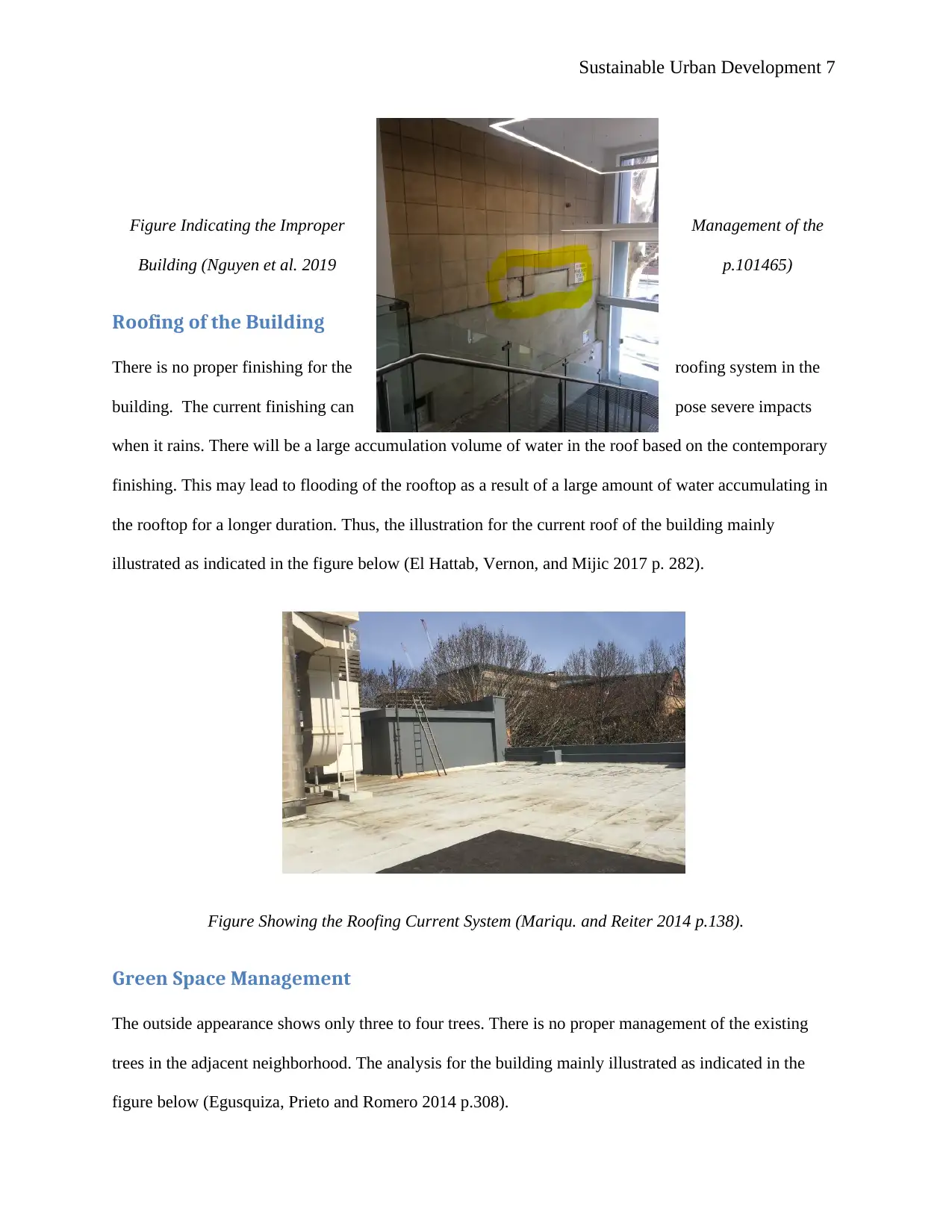
Sustainable Urban Development 7
Figure Indicating the Improper Management of the
Building (Nguyen et al. 2019 p.101465)
Roofing of the Building
There is no proper finishing for the roofing system in the
building. The current finishing can pose severe impacts
when it rains. There will be a large accumulation volume of water in the roof based on the contemporary
finishing. This may lead to flooding of the rooftop as a result of a large amount of water accumulating in
the rooftop for a longer duration. Thus, the illustration for the current roof of the building mainly
illustrated as indicated in the figure below (El Hattab, Vernon, and Mijic 2017 p. 282).
Figure Showing the Roofing Current System (Mariqu. and Reiter 2014 p.138).
Green Space Management
The outside appearance shows only three to four trees. There is no proper management of the existing
trees in the adjacent neighborhood. The analysis for the building mainly illustrated as indicated in the
figure below (Egusquiza, Prieto and Romero 2014 p.308).
Figure Indicating the Improper Management of the
Building (Nguyen et al. 2019 p.101465)
Roofing of the Building
There is no proper finishing for the roofing system in the
building. The current finishing can pose severe impacts
when it rains. There will be a large accumulation volume of water in the roof based on the contemporary
finishing. This may lead to flooding of the rooftop as a result of a large amount of water accumulating in
the rooftop for a longer duration. Thus, the illustration for the current roof of the building mainly
illustrated as indicated in the figure below (El Hattab, Vernon, and Mijic 2017 p. 282).
Figure Showing the Roofing Current System (Mariqu. and Reiter 2014 p.138).
Green Space Management
The outside appearance shows only three to four trees. There is no proper management of the existing
trees in the adjacent neighborhood. The analysis for the building mainly illustrated as indicated in the
figure below (Egusquiza, Prieto and Romero 2014 p.308).
Paraphrase This Document
Need a fresh take? Get an instant paraphrase of this document with our AI Paraphraser
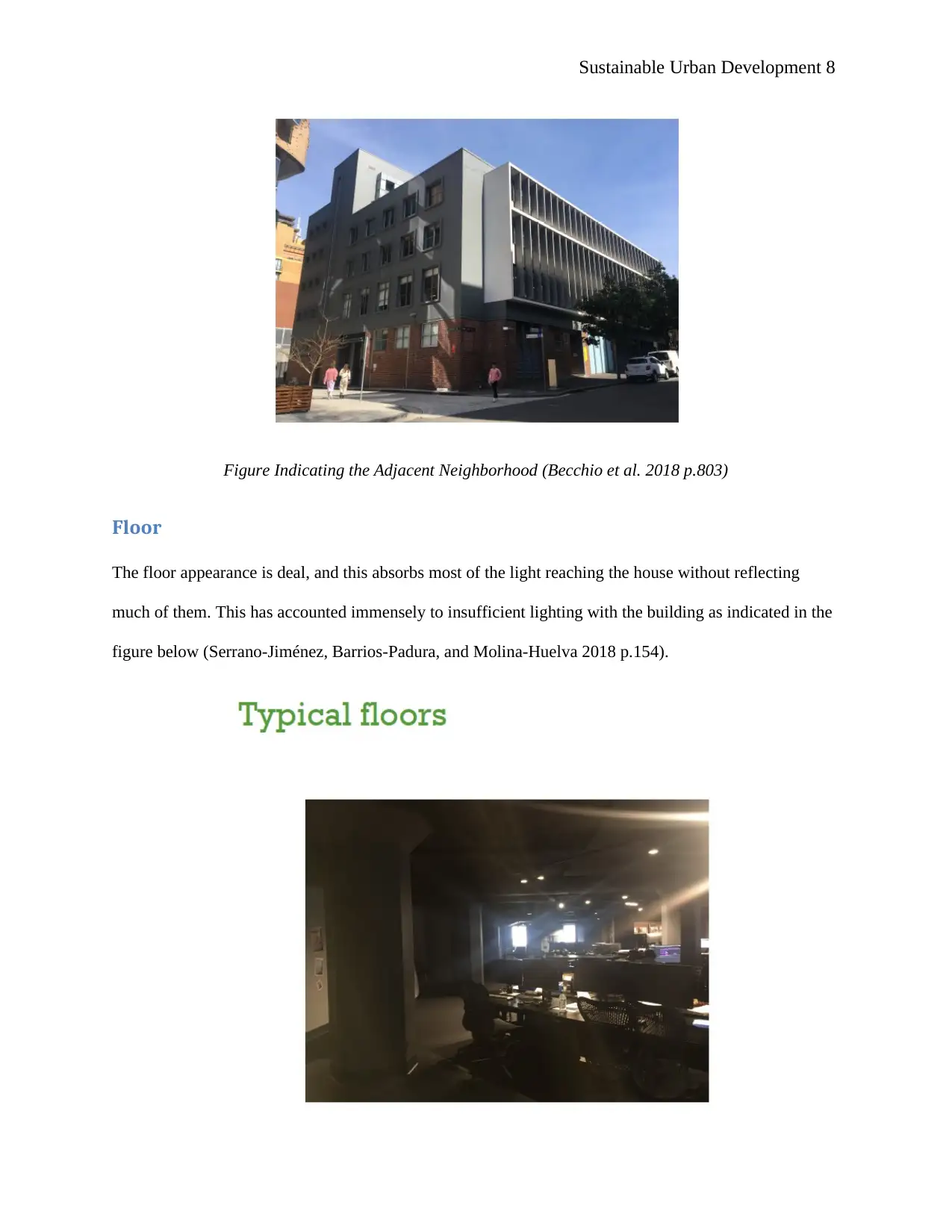
Sustainable Urban Development 8
Figure Indicating the Adjacent Neighborhood (Becchio et al. 2018 p.803)
Floor
The floor appearance is deal, and this absorbs most of the light reaching the house without reflecting
much of them. This has accounted immensely to insufficient lighting with the building as indicated in the
figure below (Serrano-Jiménez, Barrios-Padura, and Molina-Huelva 2018 p.154).
Figure Indicating the Adjacent Neighborhood (Becchio et al. 2018 p.803)
Floor
The floor appearance is deal, and this absorbs most of the light reaching the house without reflecting
much of them. This has accounted immensely to insufficient lighting with the building as indicated in the
figure below (Serrano-Jiménez, Barrios-Padura, and Molina-Huelva 2018 p.154).
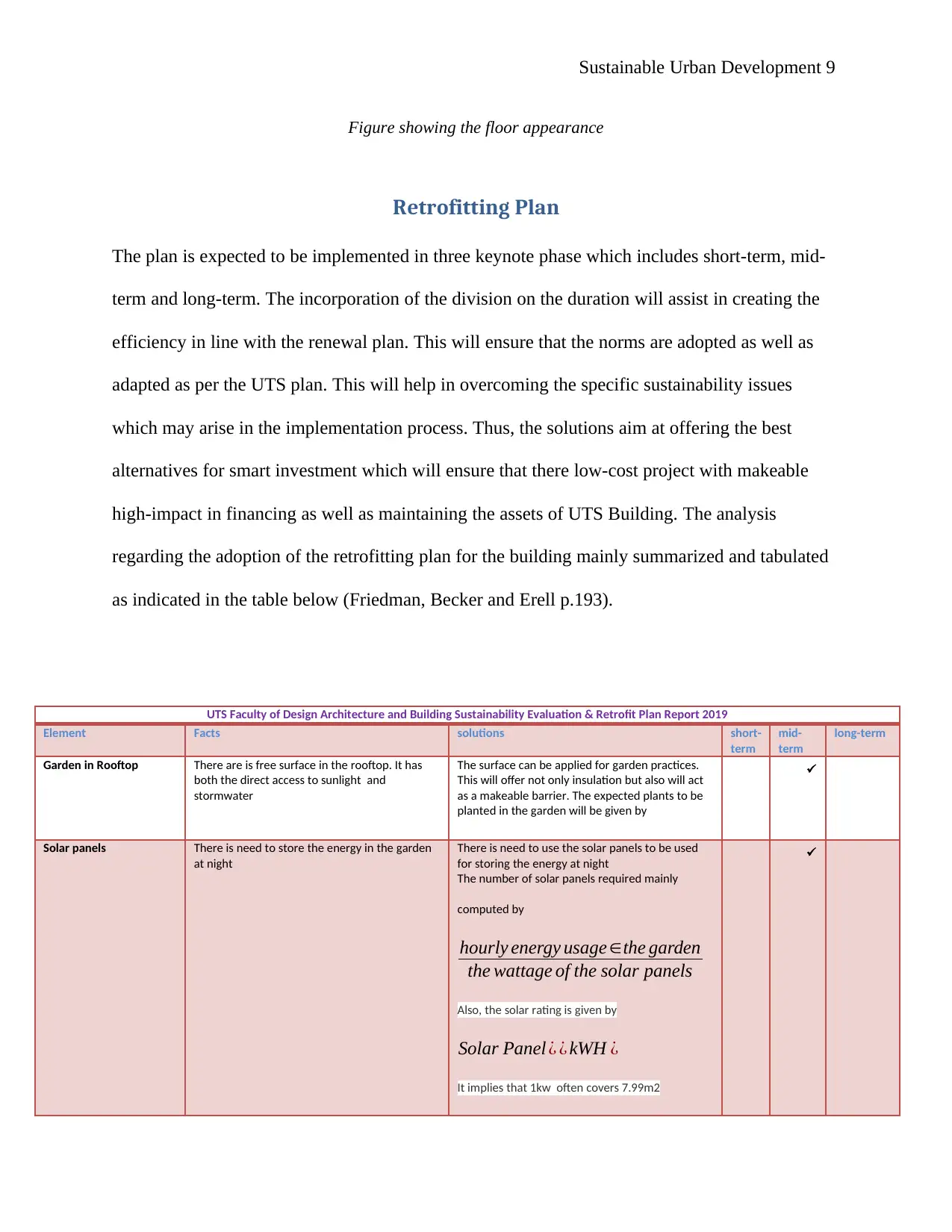
Sustainable Urban Development 9
Figure showing the floor appearance
Retrofitting Plan
The plan is expected to be implemented in three keynote phase which includes short-term, mid-
term and long-term. The incorporation of the division on the duration will assist in creating the
efficiency in line with the renewal plan. This will ensure that the norms are adopted as well as
adapted as per the UTS plan. This will help in overcoming the specific sustainability issues
which may arise in the implementation process. Thus, the solutions aim at offering the best
alternatives for smart investment which will ensure that there low-cost project with makeable
high-impact in financing as well as maintaining the assets of UTS Building. The analysis
regarding the adoption of the retrofitting plan for the building mainly summarized and tabulated
as indicated in the table below (Friedman, Becker and Erell p.193).
UTS Faculty of Design Architecture and Building Sustainability Evaluation & Retrofit Plan Report 2019
Element Facts solutions short-
term
mid-
term
long-term
Garden in Rooftop There are is free surface in the rooftop. It has
both the direct access to sunlight and
stormwater
The surface can be applied for garden practices.
This will offer not only insulation but also will act
as a makeable barrier. The expected plants to be
planted in the garden will be given by
Solar panels There is need to store the energy in the garden
at night
There is need to use the solar panels to be used
for storing the energy at night
The number of solar panels required mainly
computed by
hourly energy usage ∈the garden
the wattage of the solar panels
Also, the solar rating is given by
Solar Panel ¿ ¿ kWH ¿
It implies that 1kw often covers 7.99m2
Figure showing the floor appearance
Retrofitting Plan
The plan is expected to be implemented in three keynote phase which includes short-term, mid-
term and long-term. The incorporation of the division on the duration will assist in creating the
efficiency in line with the renewal plan. This will ensure that the norms are adopted as well as
adapted as per the UTS plan. This will help in overcoming the specific sustainability issues
which may arise in the implementation process. Thus, the solutions aim at offering the best
alternatives for smart investment which will ensure that there low-cost project with makeable
high-impact in financing as well as maintaining the assets of UTS Building. The analysis
regarding the adoption of the retrofitting plan for the building mainly summarized and tabulated
as indicated in the table below (Friedman, Becker and Erell p.193).
UTS Faculty of Design Architecture and Building Sustainability Evaluation & Retrofit Plan Report 2019
Element Facts solutions short-
term
mid-
term
long-term
Garden in Rooftop There are is free surface in the rooftop. It has
both the direct access to sunlight and
stormwater
The surface can be applied for garden practices.
This will offer not only insulation but also will act
as a makeable barrier. The expected plants to be
planted in the garden will be given by
Solar panels There is need to store the energy in the garden
at night
There is need to use the solar panels to be used
for storing the energy at night
The number of solar panels required mainly
computed by
hourly energy usage ∈the garden
the wattage of the solar panels
Also, the solar rating is given by
Solar Panel ¿ ¿ kWH ¿
It implies that 1kw often covers 7.99m2
⊘ This is a preview!⊘
Do you want full access?
Subscribe today to unlock all pages.

Trusted by 1+ million students worldwide
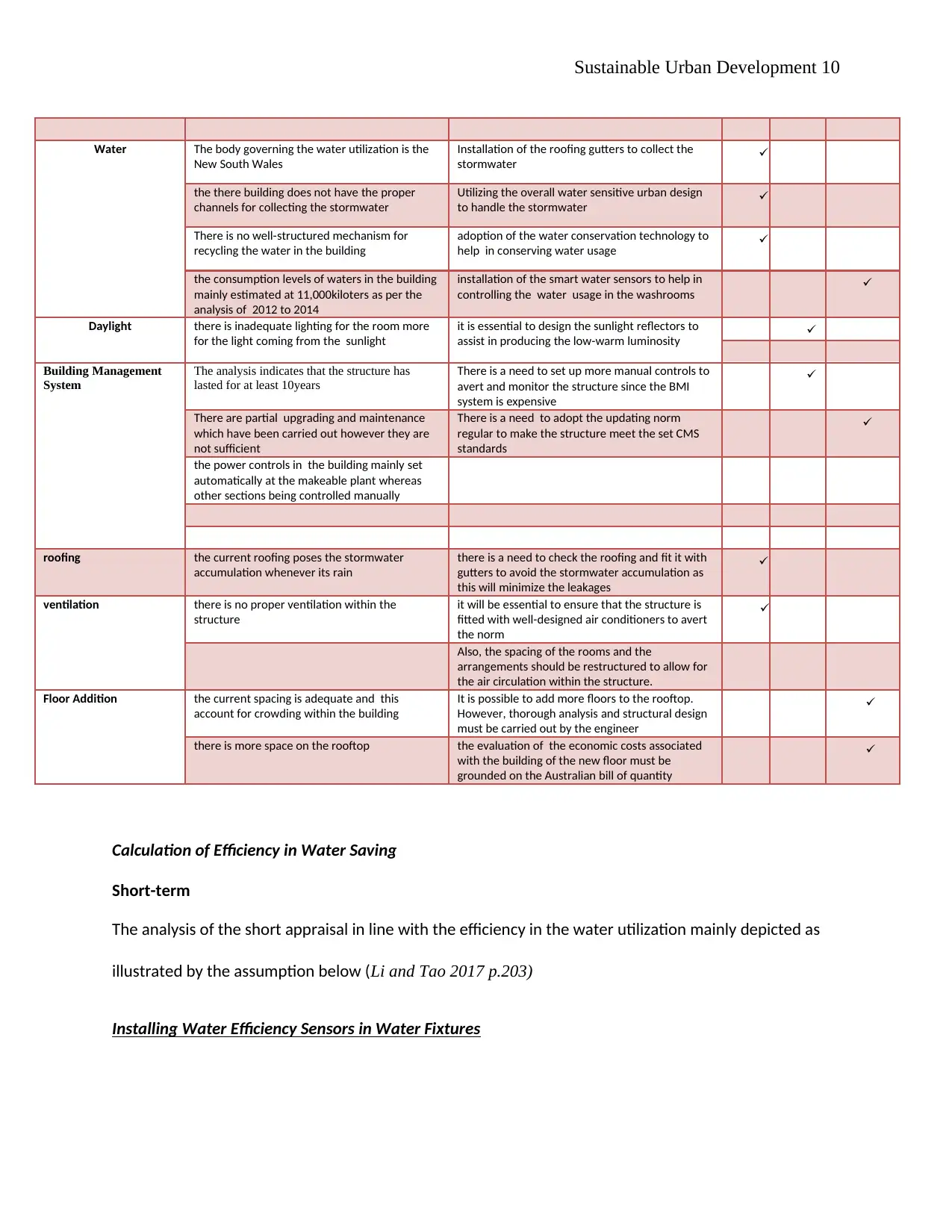
Sustainable Urban Development 10
Water The body governing the water utilization is the
New South Wales
Installation of the roofing gutters to collect the
stormwater
the there building does not have the proper
channels for collecting the stormwater
Utilizing the overall water sensitive urban design
to handle the stormwater
There is no well-structured mechanism for
recycling the water in the building
adoption of the water conservation technology to
help in conserving water usage
the consumption levels of waters in the building
mainly estimated at 11,000kiloters as per the
analysis of 2012 to 2014
installation of the smart water sensors to help in
controlling the water usage in the washrooms
Daylight there is inadequate lighting for the room more
for the light coming from the sunlight
it is essential to design the sunlight reflectors to
assist in producing the low-warm luminosity
Building Management
System
The analysis indicates that the structure has
lasted for at least 10years
There is a need to set up more manual controls to
avert and monitor the structure since the BMI
system is expensive
There are partial upgrading and maintenance
which have been carried out however they are
not sufficient
There is a need to adopt the updating norm
regular to make the structure meet the set CMS
standards
the power controls in the building mainly set
automatically at the makeable plant whereas
other sections being controlled manually
roofing the current roofing poses the stormwater
accumulation whenever its rain
there is a need to check the roofing and fit it with
gutters to avoid the stormwater accumulation as
this will minimize the leakages
ventilation there is no proper ventilation within the
structure
it will be essential to ensure that the structure is
fitted with well-designed air conditioners to avert
the norm
Also, the spacing of the rooms and the
arrangements should be restructured to allow for
the air circulation within the structure.
Floor Addition the current spacing is adequate and this
account for crowding within the building
It is possible to add more floors to the rooftop.
However, thorough analysis and structural design
must be carried out by the engineer
there is more space on the rooftop the evaluation of the economic costs associated
with the building of the new floor must be
grounded on the Australian bill of quantity
Calculation of Efficiency in Water Saving
Short-term
The analysis of the short appraisal in line with the efficiency in the water utilization mainly depicted as
illustrated by the assumption below (Li and Tao 2017 p.203)
Installing Water Efficiency Sensors in Water Fixtures
Water The body governing the water utilization is the
New South Wales
Installation of the roofing gutters to collect the
stormwater
the there building does not have the proper
channels for collecting the stormwater
Utilizing the overall water sensitive urban design
to handle the stormwater
There is no well-structured mechanism for
recycling the water in the building
adoption of the water conservation technology to
help in conserving water usage
the consumption levels of waters in the building
mainly estimated at 11,000kiloters as per the
analysis of 2012 to 2014
installation of the smart water sensors to help in
controlling the water usage in the washrooms
Daylight there is inadequate lighting for the room more
for the light coming from the sunlight
it is essential to design the sunlight reflectors to
assist in producing the low-warm luminosity
Building Management
System
The analysis indicates that the structure has
lasted for at least 10years
There is a need to set up more manual controls to
avert and monitor the structure since the BMI
system is expensive
There are partial upgrading and maintenance
which have been carried out however they are
not sufficient
There is a need to adopt the updating norm
regular to make the structure meet the set CMS
standards
the power controls in the building mainly set
automatically at the makeable plant whereas
other sections being controlled manually
roofing the current roofing poses the stormwater
accumulation whenever its rain
there is a need to check the roofing and fit it with
gutters to avoid the stormwater accumulation as
this will minimize the leakages
ventilation there is no proper ventilation within the
structure
it will be essential to ensure that the structure is
fitted with well-designed air conditioners to avert
the norm
Also, the spacing of the rooms and the
arrangements should be restructured to allow for
the air circulation within the structure.
Floor Addition the current spacing is adequate and this
account for crowding within the building
It is possible to add more floors to the rooftop.
However, thorough analysis and structural design
must be carried out by the engineer
there is more space on the rooftop the evaluation of the economic costs associated
with the building of the new floor must be
grounded on the Australian bill of quantity
Calculation of Efficiency in Water Saving
Short-term
The analysis of the short appraisal in line with the efficiency in the water utilization mainly depicted as
illustrated by the assumption below (Li and Tao 2017 p.203)
Installing Water Efficiency Sensors in Water Fixtures
Paraphrase This Document
Need a fresh take? Get an instant paraphrase of this document with our AI Paraphraser
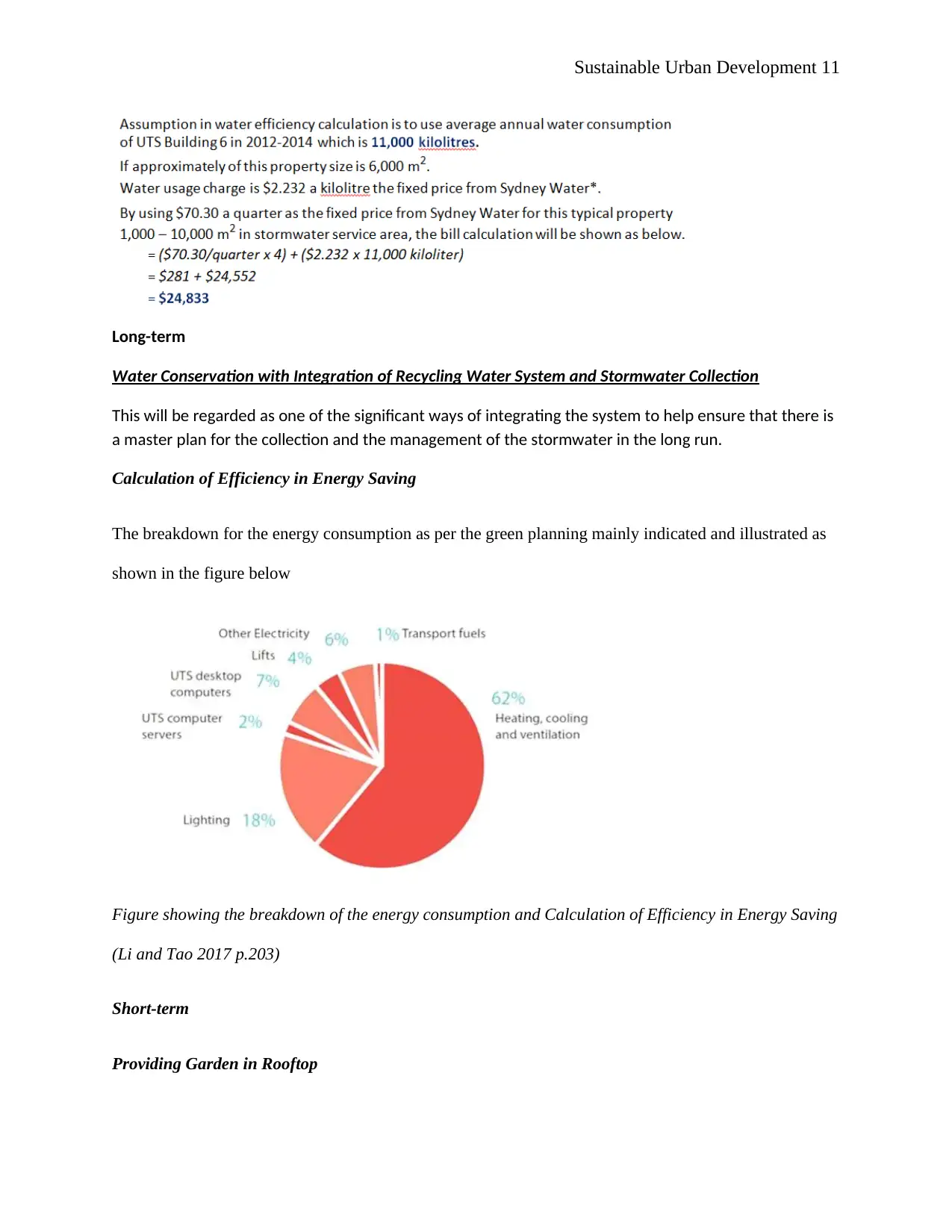
Sustainable Urban Development 11
Long-term
Water Conservation with Integration of Recycling Water System and Stormwater Collection
This will be regarded as one of the significant ways of integrating the system to help ensure that there is
a master plan for the collection and the management of the stormwater in the long run.
Calculation of Efficiency in Energy Saving
The breakdown for the energy consumption as per the green planning mainly indicated and illustrated as
shown in the figure below
Figure showing the breakdown of the energy consumption and Calculation of Efficiency in Energy Saving
(Li and Tao 2017 p.203)
Short-term
Providing Garden in Rooftop
Long-term
Water Conservation with Integration of Recycling Water System and Stormwater Collection
This will be regarded as one of the significant ways of integrating the system to help ensure that there is
a master plan for the collection and the management of the stormwater in the long run.
Calculation of Efficiency in Energy Saving
The breakdown for the energy consumption as per the green planning mainly indicated and illustrated as
shown in the figure below
Figure showing the breakdown of the energy consumption and Calculation of Efficiency in Energy Saving
(Li and Tao 2017 p.203)
Short-term
Providing Garden in Rooftop
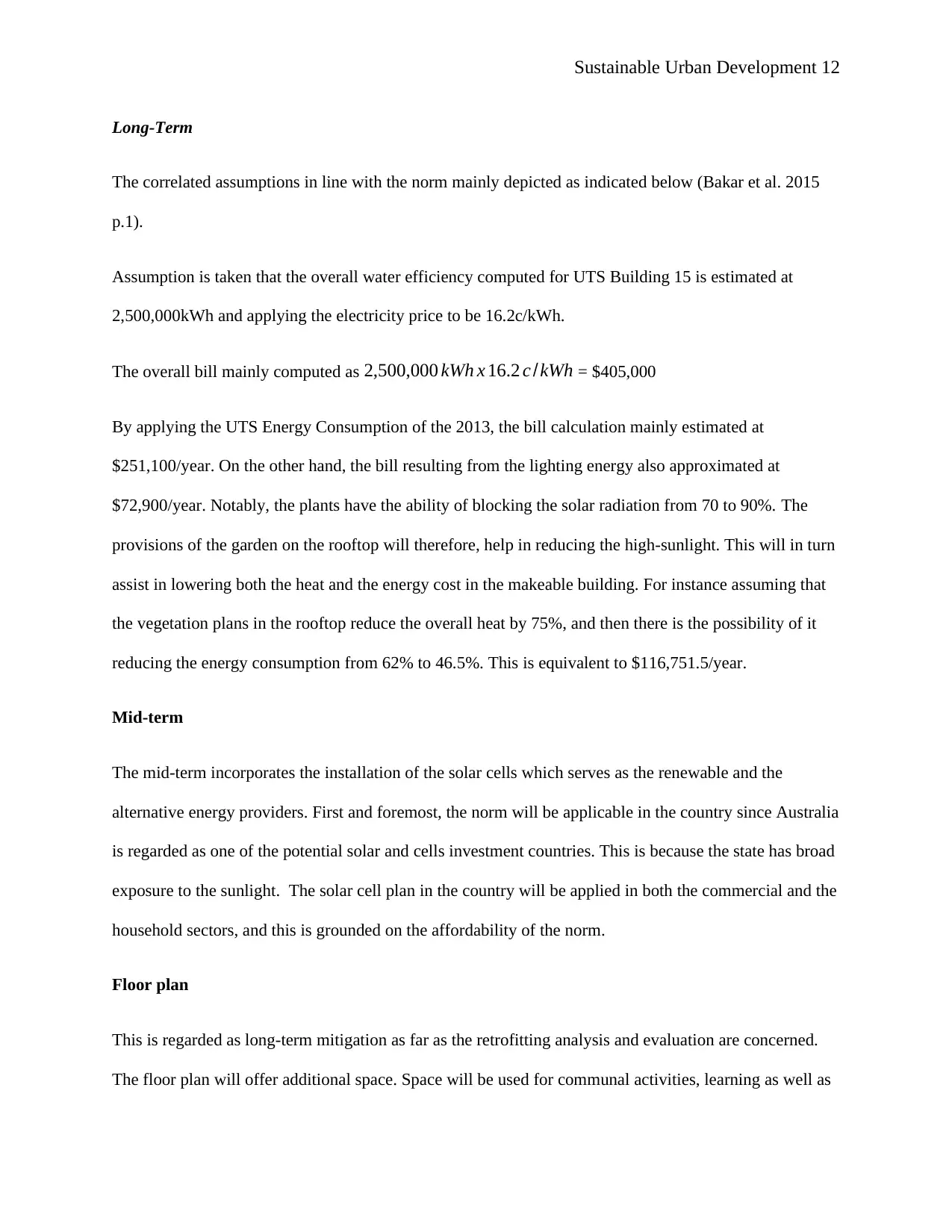
Sustainable Urban Development 12
Long-Term
The correlated assumptions in line with the norm mainly depicted as indicated below (Bakar et al. 2015
p.1).
Assumption is taken that the overall water efficiency computed for UTS Building 15 is estimated at
2,500,000kWh and applying the electricity price to be 16.2c/kWh.
The overall bill mainly computed as 2,500,000 kWh x 16.2 c /kWh = $405,000
By applying the UTS Energy Consumption of the 2013, the bill calculation mainly estimated at
$251,100/year. On the other hand, the bill resulting from the lighting energy also approximated at
$72,900/year. Notably, the plants have the ability of blocking the solar radiation from 70 to 90%. The
provisions of the garden on the rooftop will therefore, help in reducing the high-sunlight. This will in turn
assist in lowering both the heat and the energy cost in the makeable building. For instance assuming that
the vegetation plans in the rooftop reduce the overall heat by 75%, and then there is the possibility of it
reducing the energy consumption from 62% to 46.5%. This is equivalent to $116,751.5/year.
Mid-term
The mid-term incorporates the installation of the solar cells which serves as the renewable and the
alternative energy providers. First and foremost, the norm will be applicable in the country since Australia
is regarded as one of the potential solar and cells investment countries. This is because the state has broad
exposure to the sunlight. The solar cell plan in the country will be applied in both the commercial and the
household sectors, and this is grounded on the affordability of the norm.
Floor plan
This is regarded as long-term mitigation as far as the retrofitting analysis and evaluation are concerned.
The floor plan will offer additional space. Space will be used for communal activities, learning as well as
Long-Term
The correlated assumptions in line with the norm mainly depicted as indicated below (Bakar et al. 2015
p.1).
Assumption is taken that the overall water efficiency computed for UTS Building 15 is estimated at
2,500,000kWh and applying the electricity price to be 16.2c/kWh.
The overall bill mainly computed as 2,500,000 kWh x 16.2 c /kWh = $405,000
By applying the UTS Energy Consumption of the 2013, the bill calculation mainly estimated at
$251,100/year. On the other hand, the bill resulting from the lighting energy also approximated at
$72,900/year. Notably, the plants have the ability of blocking the solar radiation from 70 to 90%. The
provisions of the garden on the rooftop will therefore, help in reducing the high-sunlight. This will in turn
assist in lowering both the heat and the energy cost in the makeable building. For instance assuming that
the vegetation plans in the rooftop reduce the overall heat by 75%, and then there is the possibility of it
reducing the energy consumption from 62% to 46.5%. This is equivalent to $116,751.5/year.
Mid-term
The mid-term incorporates the installation of the solar cells which serves as the renewable and the
alternative energy providers. First and foremost, the norm will be applicable in the country since Australia
is regarded as one of the potential solar and cells investment countries. This is because the state has broad
exposure to the sunlight. The solar cell plan in the country will be applied in both the commercial and the
household sectors, and this is grounded on the affordability of the norm.
Floor plan
This is regarded as long-term mitigation as far as the retrofitting analysis and evaluation are concerned.
The floor plan will offer additional space. Space will be used for communal activities, learning as well as
⊘ This is a preview!⊘
Do you want full access?
Subscribe today to unlock all pages.

Trusted by 1+ million students worldwide
1 out of 16
Related Documents
Your All-in-One AI-Powered Toolkit for Academic Success.
+13062052269
info@desklib.com
Available 24*7 on WhatsApp / Email
![[object Object]](/_next/static/media/star-bottom.7253800d.svg)
Unlock your academic potential
Copyright © 2020–2025 A2Z Services. All Rights Reserved. Developed and managed by ZUCOL.





